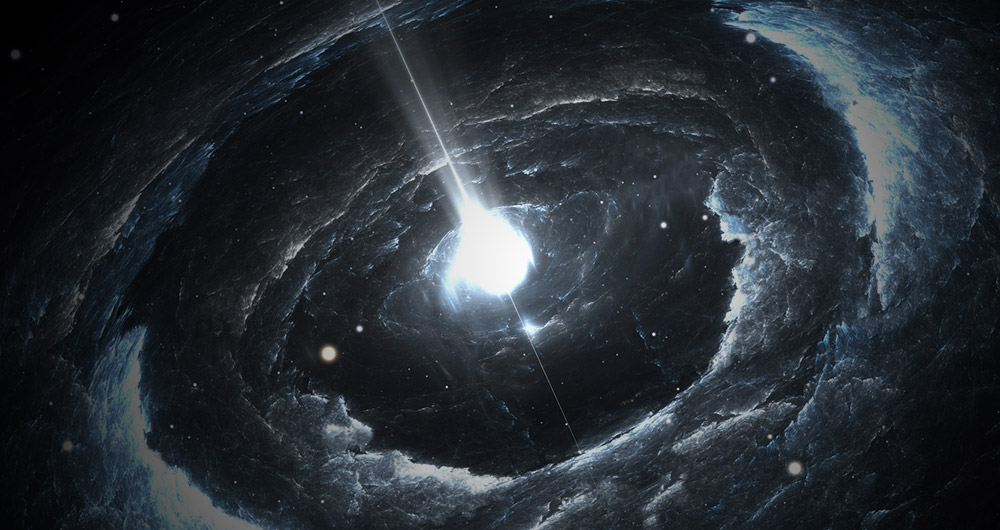Unexplained light: Astrophysicists have discovered the lightest neutron star to date in a supernova remnant. The slender remnant of the star weighs only about 0.77 solar masses, and is therefore half as heavy as usual for neutron stars. This raises the question of how this light weight appears and what is hidden inside. Because low mass can also indicate strange states of matter, the researchers reported in “Nature Astronomy.”
A neutron star is formed when a massive star explodes in a supernova at the end of its life cycle. What remains is a star core that is only 20-30 km in size, but has a mass of gwith two suns can unite. The density and pressure inside a neutron star is so high that even atoms decay and only neutrons remain. In essence, this creates a strange, The superfluid state of matter.
“The observation of unusually light and heavy neutron stars is particularly interesting because they extend the range of central densities,” Viktor Doroshenko and colleagues from the University of Tübingen explain. Because such extremes can be used to verify common models of the inner workings of such stellar remnants.

Radioactive residue in a dusty shell
The neutron star, which Doroshenko and his team have now examined in more detail, is even more exciting. The compact stellar remnant lies within the glowing dust and gas envelope of the supernova remnant, and was discovered a few years ago using the HESS gamma-ray observatory in Namibia. Subsequent observations using X-ray telescopes confirmed that HESS J1731-347 was a cold neutron star.
However, the size and weight of this neutron star remained unclear at first. Only last year, with the help of the European Gaia satellite, astronomers determined the exact location of HESS’ partner star J1731-347 lying in the same supernova envelope. This allowed Doroshenko and his colleagues to evaluate and use all the observational data on this object to determine the mass and size of the neutron star.
“This allowed us to fix previous errors and improve our models. The mass and radius of the neutron star can be determined with much greater accuracy than previously possible,” explains co-author Valery Suleymanov.
Lighter than the theory allows
The analyzes revealed something surprising: the neutron star HESS J1731-347, which has a radius of only 10.4 kilometers, is a rather slender representative of its kind. Even more unusual is its mass of only 0.77 solar masses. Thus, a nest of stars weighs only half the weight of a typical neutron star. “Our estimate of mass makes HESS J1731-347 the lightest neutron star known to date,” the astrophysicists say.
In fact, a neutron star is so light that conventional models of interpretation are reaching their limits. Because how heavy progenitor stars are and how much mass they lose during the primary collapse and subsequent explosion is determined by the laws of astrophysics – in fact. According to them, the formation of neutron stars less than 1.17 solar masses is considered “problematic”. The previously lightest known sample was almost over this limit with 1,174 solar masses.
Is it a quark star?
However, this differs with HESS J1731-347: if its lower mass is confirmed, it would far exceed the theoretical limit of just 0.77 solar masses. “Such a light neutron star is thus a very exciting object from an astrophysical perspective,” Doroshenko and colleagues wrote. “A confirmed breach of the theoretical limit could have major implications for our understanding of neutron star formation and physics.”
It’s not even clear if the star’s remnant is an ordinary neutron star at all. Because astrophysicists do not rule out that HESS J1731-347 quark star could be. Only so far these hypothetical objects are denser than neutron stars, which is why even neutrons in their interior decay. In the midst of such things should be a quark-gluon soup similar to that seen shortly after the Big Bang. “This is currently the most promising candidate for the quark star that we know so far,” says co-author Andrea Santangelo.
stay sexy
But even if the object in the center of HESS J1731-347 is a “normal” neutron star, it remains a particularly interesting thing. “It allows us to study the as yet undiscovered part of the parameter space in the mass plane of the radius of neutron stars,” says Santangelo. “This gives us valuable clues about the equation of the dense state of matter, which can be used to describe its properties.” (Nature Astronomy, 2022; doi: 10.1038/s41550-022-01800-1)
Source: Nature Astronomy, Eberhard Karls University of Tübingen

“Total coffee aficionado. Travel buff. Music ninja. Bacon nerd. Beeraholic.”








More Stories
Coral Seeding: Artificial Insemination Makes Coral More Heat Tolerant
Fear, Anger, and Denial: How People Respond to Climate Change – Research
LKH Graz: Using radiation to combat heart arrhythmias